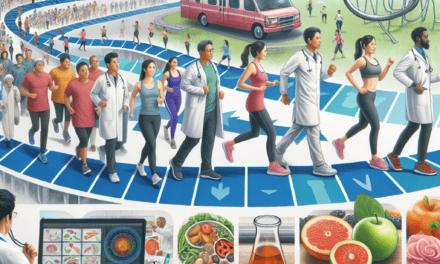-
Table of Contents
- Alternative Medicine: Its Role and Recognition in Healthcare
- 1. The Historical Context of Alternative Medicine
- 1.1 Ancient Practices and Philosophies
- 1.2 The Rise of Western Medicine
- 1.3 The Resurgence of Interest in Alternative Medicine
- 1.4 The Role of Cultural and Social Factors
- 1.5 The Impact of Globalization
- 2. Types of Alternative Medicine
- 2.1 Traditional Chinese Medicine (TCM)
- 2.2 Ayurveda
- 2.3 Homeopathy
- 2.4 Naturopathy
- 2.5 Mind-Body Medicine
Alternative Medicine: Its Role and Recognition in Healthcare

Alternative medicine has been a topic of interest and debate for decades. As healthcare systems around the world evolve, the role of alternative medicine in providing holistic and patient-centered care is increasingly recognized. This article delves into the various aspects of alternative medicine, exploring its history, types, integration into mainstream healthcare, effectiveness, and the challenges it faces. By examining these facets, we aim to provide a comprehensive understanding of alternative medicine’s place in modern healthcare.
1. The Historical Context of Alternative Medicine
Alternative medicine, often referred to as complementary and alternative medicine (CAM), encompasses a wide range of practices that fall outside the realm of conventional Western medicine. To understand its current role, it is essential to explore its historical roots and evolution over time.
1.1 Ancient Practices and Philosophies
Alternative medicine has its origins in ancient healing traditions that date back thousands of years. Many of these practices are deeply rooted in cultural and spiritual beliefs. For instance, Traditional Chinese Medicine (TCM) and Ayurveda from India are two of the oldest systems of medicine, both emphasizing balance and harmony within the body.
TCM, which includes practices like acupuncture and herbal medicine, is based on the concept of Qi (vital energy) and the balance of Yin and Yang. Similarly, Ayurveda focuses on balancing the body’s three doshas (Vata, Pitta, and Kapha) to maintain health. These ancient systems have been practiced for millennia and continue to be popular today.
1.2 The Rise of Western Medicine
With the advent of modern science and technology, Western medicine began to dominate the healthcare landscape in the 19th and 20th centuries. The development of antibiotics, vaccines, and advanced surgical techniques led to significant improvements in public health and life expectancy.
However, this shift also led to the marginalization of traditional healing practices. Many alternative therapies were dismissed as unscientific or ineffective, leading to a decline in their use in mainstream healthcare settings.
1.3 The Resurgence of Interest in Alternative Medicine
In recent decades, there has been a resurgence of interest in alternative medicine, driven by a growing demand for holistic and patient-centered care. This renewed interest is partly due to the limitations of conventional medicine in addressing chronic diseases and the side effects associated with pharmaceutical treatments.
Patients are increasingly seeking out alternative therapies to complement conventional treatments, leading to a more integrative approach to healthcare. This trend is reflected in the growing number of healthcare providers who incorporate alternative therapies into their practice.
1.4 The Role of Cultural and Social Factors
Cultural and social factors play a significant role in the acceptance and use of alternative medicine. In many cultures, traditional healing practices are deeply ingrained and continue to be an integral part of healthcare.
For example, in countries like China and India, alternative medicine is often used alongside conventional treatments. In Western countries, the multicultural population has contributed to the growing popularity of alternative therapies, as people seek treatments that align with their cultural beliefs and values.
1.5 The Impact of Globalization
Globalization has facilitated the exchange of knowledge and practices across cultures, leading to a greater awareness and acceptance of alternative medicine worldwide. This cross-cultural exchange has enriched the field of alternative medicine, introducing new therapies and approaches to healthcare.
As a result, alternative medicine is no longer confined to specific regions or cultures but is increasingly recognized as a valuable component of global healthcare systems.
2. Types of Alternative Medicine
Alternative medicine encompasses a diverse range of practices and therapies, each with its own unique philosophy and approach to healing. Understanding these different types is crucial for appreciating the breadth and depth of alternative medicine.
2.1 Traditional Chinese Medicine (TCM)
Traditional Chinese Medicine is a comprehensive system of healthcare that has been practiced for over 2,000 years. It includes various modalities such as acupuncture, herbal medicine, tai chi, and qi gong.
Acupuncture, one of the most well-known TCM practices, involves the insertion of thin needles into specific points on the body to balance the flow of Qi. Studies have shown that acupuncture can be effective in treating conditions such as chronic pain, migraines, and nausea.
Herbal medicine is another key component of TCM, with practitioners using a wide range of plant-based remedies to treat various ailments. The use of herbs is tailored to the individual’s specific needs, taking into account their unique constitution and health condition.
2.2 Ayurveda
Ayurveda, which originated in India over 3,000 years ago, is one of the world’s oldest holistic healing systems. It emphasizes the balance of mind, body, and spirit to achieve optimal health.
Ayurvedic treatments often include dietary changes, herbal remedies, yoga, and meditation. The practice is based on the belief that each person has a unique constitution, or dosha, which determines their physical and mental characteristics.
Research has shown that Ayurveda can be effective in managing chronic conditions such as arthritis, diabetes, and cardiovascular disease. Its focus on lifestyle and dietary modifications aligns with modern approaches to preventive healthcare.
2.3 Homeopathy
Homeopathy is a system of medicine developed in the late 18th century by Samuel Hahnemann. It is based on the principle of “like cures like,” meaning that a substance that causes symptoms in a healthy person can be used to treat similar symptoms in a sick person.
Homeopathic remedies are highly diluted substances that are believed to stimulate the body’s natural healing processes. While homeopathy remains controversial, with critics questioning its scientific basis, many patients report positive outcomes from its use.
Some studies suggest that homeopathy may be effective in treating conditions such as allergies, asthma, and anxiety, although more research is needed to confirm these findings.
2.4 Naturopathy
Naturopathy is a holistic approach to healthcare that emphasizes the body’s innate ability to heal itself. It combines traditional healing practices with modern medical knowledge to promote overall well-being.
Naturopathic treatments may include dietary and lifestyle changes, herbal medicine, acupuncture, and physical therapies. Naturopaths often focus on identifying and addressing the root causes of illness rather than merely treating symptoms.
Research has shown that naturopathy can be effective in managing chronic conditions such as hypertension, diabetes, and depression. Its emphasis on preventive care and patient education aligns with current trends in healthcare.
2.5 Mind-Body Medicine
Mind-body medicine encompasses a range of practices that focus on the interaction between the mind and body to promote health and well-being. These practices include meditation, yoga, tai chi, and biofeedback.
Research has shown that mind-body practices





